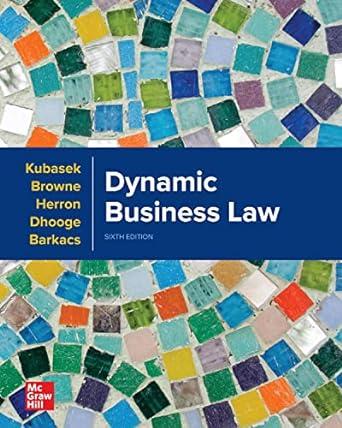Shiloh supplies equipment to the automotive and commercial vehicle markets and other industrial customers. It specializes in
Question:
Shiloh supplies equipment to the automotive and commercial vehicle markets and other industrial customers. It specializes in materials and designs that reduce vehicle weight and increase fuel efficiency, as well as products that mitigate the harshness of vehicles, due to their noise and vibration. Shares of Shiloh, which is headquartered in Ohio, are publicly traded on the Nasdaq Stock Market.
In 2015, an accountant at Shiloh’s Wellington, Ohio, facility (“the Wellington Facility”) sounded the alarm on possible fraudulent accounting. In response, Shiloh launched an internal investigation. The investigation revealed that the Wellington Facility’s Controller, Eric Halterman, had been intentionally understating the Facility’s costs. When Halterman’s data was consolidated into the Company’s financial reports, the effect was to falsely inflate Shiloh’s net income. After Shiloh publicly announced the investigation, its share price fell. The share price dropped again after the Company restated its financials and admitted to investors that its internal controls on reporting were materially weak. A putative class of Shiloh shareholders then filed this suit.
JUDGE WOOD Section 10 (b) of the Exchange Act and SEC Rule 10b-5 make it “unlawful for any person … [t]o make any untrue statement of a material fact or to omit to state a material fact necessary in order to make the statements made, in the light of the circumstances under which they were made, not misleading.
To state a claim under Section 10 (b) and Rule 10b-5, “a plaintiff must prove (1) a material misrepresentation or omission by the defendant; (2) scienter; (3) a connection between the misrepresentation or omission and the purchase or sale of a security; (4) reliance upon the misrepresentation or omission; (5)
economic loss; and (6) loss causation.” The focus here is narrowed to the element of scienter—more precisely, whether the SACAC adequately alleges that Shiloh had the corporate scienter required to state a claim for relief under Section 10 (b) and Rule 10b-5. Taking the allegations as a whole, Plaintiffs still have not demonstrated that Halterman was sufficiently senior at Shiloh for his scienter to be imputed to the Company. In his role, Halterman was at least two levels removed from Shiloh’s executive-level management: He reported to Harvey, the Group Controller, who in turn reported to the Company’s Vice President of Finance. Far from being in charge of an entire division or region, Halterman supervised accounting at just one of Shiloh’s twenty-one plants. The fact that Halterman updated Shiloh’s executives on the Wellington Facility’s financials during weekly calls does not change the nature of his role within the Company—that is, he remained a low- to mid-level manager responsible for just a slice of the Company’s accounting.
Plaintiffs’ assertion that Shiloh managed the Wellington Facility (and thus Halterman) in a “hands-off” way does not alter this conclusion. Even crediting this conclusory allegation, Plaintiffs fail to explain why hands-off management would elevate Halterman’s relative role within the company in a way that changes the imputation analysis.
Plaintiffs urge this Court to find Halterman’s rank at Shiloh akin to that of a “regional manager” or head of a business unit, arguing that courts in this district have imputed the scienter of such individuals to their employer corporations. But the decisions on which Plaintiffs rely involved employees who were comparatively more senior at their companies than Halterman was at Shiloh, and included allegations of scienter that went beyond a single individual. To be sure, where an employee falls on a corporation’s organizational chart may not always be determinative of whether his or her scienter may be imputed to the corporation. But the fact that an employee is not pan of senior management weighs strongly against imputation.
This does not mean the individual with scienter and the individual who made the alleged misrepresentation need always be the same person in order for a plaintiff to plead corporate scienter. But this does not help Plaintiffs. Even assuming the maker of the false statement and the employee with scienter need not be one and the same, as Plaintiffs argue, the issue here is whether, given Halterman’s (lack of) seniority, his scienter may be imputed to Shiloh. The answer is it may not.
CRITICAL THINKING:
Can you think of any additional information that, if it existed, might have helped the plaintiff win this appeal?
ETHICAL DECISION MAKING:
Which stakeholders’ interests were furthered by this decision, and which stakeholder’s interests were not?
Step by Step Answer:

Dynamic Business Law
ISBN: 9781260733976
6th Edition
Authors: Nancy Kubasek, M. Neil Browne, Daniel Herron, Lucien Dhooge, Linda Barkacs





